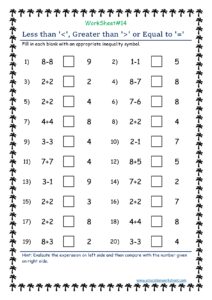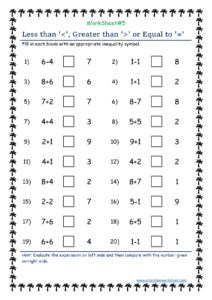Worksheets for evaluating and comparing expressions
-
Key Components of the Worksheets:
- Evaluating Expressions: This section of the worksheets focuses on the fundamental skill of evaluating expressions. Students are provided with various algebraic expressions containing variables. They are required to substitute specific values for these variables and compute the resulting numerical values. By working through these exercises, students become adept at applying the order of operations, which is essential in algebra.
- Comparing Expressions: The “Comparing Expressions” section introduces students to the world of mathematical inequalities. It presents pairs of expressions and challenges students to determine which expression is greater, lesser, or if they are equal for given variable values. This enhances their ability to analyze and compare mathematical expressions, a skill essential in making decisions based on mathematical models.
- Mixed Practice: The mixed practice section combines both evaluating and comparing tasks. It includes exercises that require students to evaluate expressions and then make comparisons, often incorporating real-world scenarios. This allows learners to apply multiple concepts simultaneously, fostering a holistic understanding of algebraic expressions.
Educational Benefits:
- Algebraic Proficiency: These worksheets help build a strong foundation in algebra, ensuring students can confidently manipulate and analyze expressions.
- Problem-Solving Skills: Through the process of evaluating and comparing expressions, students develop analytical and critical thinking skills, which are valuable across various fields and disciplines.
- Real-World Application: Many exercises in these worksheets are inspired by real-life situations, making the learning experience practical and relevant.
- Preparation for Advanced Mathematics: Proficiency in evaluating and comparing expressions is a stepping stone to more advanced mathematical concepts in algebra, calculus, and beyond.

Worksheets for evaluating and comparing expressions - Self-Paced Learning: These worksheets are equally suitable for classroom use or as self-study resources, allowing students to learn at their own pace and revisit concepts as needed.
- Assessment Tool: Educators can use these worksheets as assessment tools to gauge a student’s grasp of algebraic concepts and adjust their teaching accordingly.
Worksheets for evaluating and comparing expressions In summary, “Worksheets for Evaluating and Comparing Expressions” are versatile educational materials that facilitate the development of essential algebraic skills. They empower learners to navigate complex mathematical problems with confidence and precision while nurturing their analytical abilities and mathematical acumen.
Evaluating and comparing expressions can be an important aspect of mathematics and algebra. Here are some example worksheets that you can use to practice evaluating and comparing expressions:
Worksheet 1: Evaluating Expressions
- Evaluate the expression when �=3: a. 3�+5 b. 2�2−4�+7 c. 12�+3
- Evaluate the expression when �=−2: a. 4�3−2�2+5�−1 b. 2�3+8 c. −�4+3�2−1
- Simplify the following expressions: a. 2(�+4)−3(2�−1) b. 3(2�−5)−4(�−7)
Worksheet 2: Comparing Expressions
- Compare the expressions and determine which one is greater for the given values of �: a. 2�2+3�−1 and �3−4�2+2�+1, when �=2 b. 5�2+3� and �3−2�, when �=1
- Compare the expressions and determine which one is greater for the given values of �: a. 2�3−3�+5 and 3�2−2�−4, when �=−2 b. �4−2�3+3�2 and �3−�2+�, when �=0

Worksheets for evaluating and comparing expressions
Worksheet 3: Mixed Practice
- Evaluate the following expressions when �=4 and �=−3: a. 2�+5� b. �2−�2 c. ��
- Compare the expressions and determine which one is greater for the given values of �: a. �2−2�+3 and �3−4�2+2�+1, when �=1 b. 4�2−3� and �4−2�2, when �=−2
- Simplify the following expressions: a. 5(�+2)−2(3�−1) b. 2(4�−3)−3(2�+5)
Feel free to customize these worksheets and add more problems as needed. These worksheets are designed to help you practice evaluating and comparing expressions in algebra, which are fundamental skills in mathematics.

